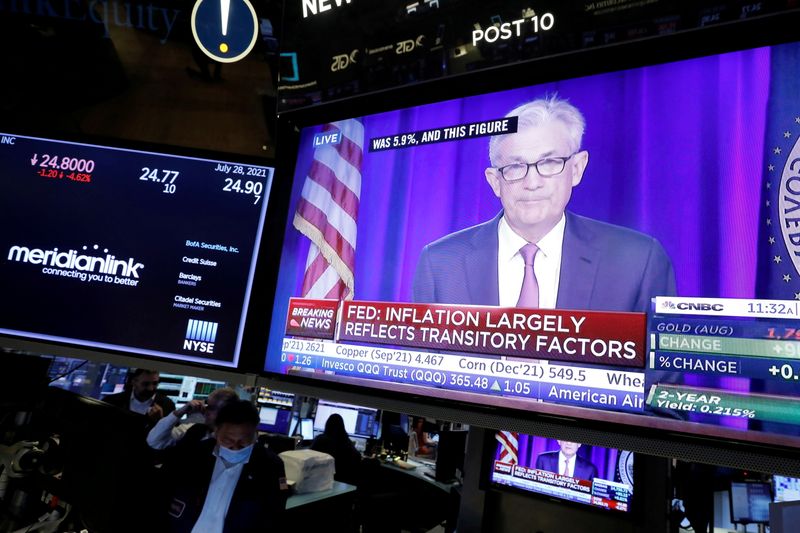By Yoruk Bahceli
(Reuters) -If bond markets are taken at their word, the world post-pandemic will be defined by stagflation, a toxic scenario that appears at odds with the bounceback indicated by robust economic data and record-high equities.
The flagging of stagflation - high-inflation coupled with low growth - is puzzling, and according to many investors, not trustworthy. Instead, they say, it is a reflection of how central banks' grip over bond markets has distorted markets' signalling power.
Bond yields, nominal as well as "real" ones, which strip out expected inflation, have plunged in the United States and the euro area. Their message: weak growth, requiring years of ultra-loose monetary policy.
Yet, while real 10-year yields on U.S. inflation-protected securities (TIPS) have halved since late March to a record low below -1.20%, a measure of future inflation, known as the breakeven rate, hasn't fallen far from this year's highs.
The 10-year U.S. breakeven rate, the inflation level where returns on nominal bonds and TIPS would be equal, is now at 2.35%.
"It's almost implying that markets are pricing in some form of stagflation," said Craig Inches, head of rates and cash at Royal London Asset Management (RLAM).
He said markets appeared to expect "inflation rates stay high and nominal yields continue to come lower."
Indeed, with inflation data surprising to the upside, the risk is that inflation could be less transitory than central banks believe. U.S. consumers too see inflation at 2.8% in five years time, the University of Michigan's latest monthly survey shows.
It's the message from yields that's at odds with robust growth expectations, recently upgraded by the IMF.
"The only way you can get to (a stagflation) synopsis is if you believe that the vaccines don't work," Inches said.
GROWTH SLOWING, NOT REVERSING
Still, there are several reasons why investors may lose exuberance about the growth picture.
First, new COVID-19 variants, which according to a Deutsche Bank (DE:DBKGn) survey have become the top concern for financial markets.
Second, slowing economic momentum, as U.S. data surprises have turned negative, according to indexes compiled by Citi.
Still, even with all that, Annalisa Piazza, fixed income research analyst at MFS Investment Management, is sceptical of how bond markets seem to be reading the data.
"We're clearly not heading towards a recession," she said. While acknowledging sentiment indicators have likely peaked and growth will moderate, the data "are consistent globally with a pace of growth that is very strong," she said.
Markets have even dialled back longer-term rate hike expectations, seemingly fearing a premature Fed policy tightening choking off recovery.
Interest rate swaps now imply the Fed policy rate in five years' time - a proxy for the "terminal" interest rate - to be 1.14%, ING Bank notes. Back in March it was expected to be some 70 bps higher.
That's less than half the 2.5% Fed rate-setters expect in the longer run. Effectively, the market is suggesting growth will undershoot Fed projections.
RLAM's Inches says however that in a genuine growth scare, yields and breakevens would be unlikely to send contradictory signals.
Instead a bond rally would be accompanied by a collapse in breakeven rates, stocks and corporate bonds as was the case during the 2020 COVID scare, investors said.
DISTORTIONS
The danger lies in reading too much into what's being said by markets tightly controlled by central banks.
In the United States, the three-month moving average of what is left of net Treasury issuance for investors to buy after Fed purchases, has declined steadily this year and turned negative in July, according to Reuters calculations based on Fed and industry group SIFMA data.
Another issue is shrinking liquidity in the $1.6 trillion TIPS market. The Fed holds over 20%, up from less than 10% in early 2020, data from the Fed and SIFMA show.
Record inflows into the TIPS market from investors snapping up inflation protection have exacerbated the squeeze further.
That's left TIPS investors paying a premium to own an asset that's less liquid than nominal Treasuries, said Allianz (DE:ALVG) senior economist Patrick Krizan.
Krizan calculates that after adjusting for liquidity the TIPS yield would have been -0.52% last week, far above a record low.
As real yields directly feed into breakevens, an artificially low reading implies breakevens are overstating inflation expectations.
"It's way too aggressive, the drop in rates," ING senior rates strategist Antoine Bouvet said. "The rates markets, they don't just reflect economic developments but also supply-demand imbalances."

That's why, citing the economic recovery ahead, many investors still expect 10-year Treasury yields to rise to near 2% by the end of the year. Even Fed boss Jerome Powell admitted the challenges of decoding what bond markets say.
Technical factors are "where you put things that you can't quite explain," Powell said recently.